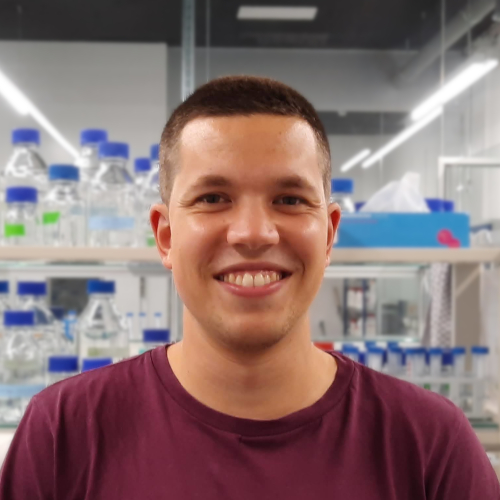 |
| Post Doc. U177/U176 nicolas.dolder@unibe.ch |
Kinetic measurements of membrane proteins in giant unilamellar vesicles (GUVs)
Background
Membrane proteins (MPs) are key players in many cellular processes and carry out many important functions in the cell, such as solute transport across the, signal transduction via receptors and energy conversion, for example during oxidative phosphorylation or the transformation of solar energy to ATP [1]. Due to their important role in the cell, it is not surprising that aberrant expression or activity of MPs can be linked to many diseases and the fact that many of these proteins appear on the surface of the cell makes them useful drug targets, in fact it is estimated that about 50% – 60% of currently developed drugs target MPs [2].
To properly investigate the function of an MP and measure its activity, the protein needs to be purified and incorporated into membrane mimetic systems such as liposomes or nanodiscs. Gaint unilamellar vesicles (GUVs) are a very promising system as their size is close to that of a cell and thus they can be observed using light microscopy. The ability to monitor single vesicles also decreases the amount of protein needed, which would be beneficial for the investigation of eukaryotic MPs, as they are often expressed with lower yields compared to bacterial MPs [3]. Recently, our group published a detergent-free method using charge mediated fusion to incorporate MPs into GUVs, the next step should thus be to perform kinetic measurements with those GUVs [4].
Project
The aim of this project is to functionally reconstitute MPs into GUVs using charge mediated fusion and perform kinetic measurements using a microscope. To measure the activity of the protein, appropriate assays must be established and the reagents, such as fluorophores or enzymes creating a fluorescent or luminescent signal, must be incorporated into the GUVs.
References
- Tiefenauer, L., & Demarche, S. (2012). Challenges in the Development of Functional Assays of Membrane Proteins. Materials, 5(11), 2205–2242. doi: 10.3390/ma5112205
- Bull, S. C., & Doig, A. J. (2015). Properties of Protein Drug Target Classes. PLoS ONE, 10(3), e0117955. doi: 10.1371/journal.pone.0117955
- Lyons, J. A., Shahsavar, A., Paulsen, P. A., Pedersen, B. P., Nissen, P. Expression strategies for structural studies of eukaryotic membrane proteins. Current Opinion in Structural Biology, Volume 38, 2016, Pages 137-144, doi: 10.1016/j.sbi.2016.06.011
- Biner O., Schick T., Müller Y., von Ballmoos C. (2016) Delivery of membrane proteins into small and giant unilamellar vesicles by charge-mediated fusion. FEBS Letters, 2016 Jul;590(14):2051-62. doi: 10.1002/1873-3468.12233. Epub 2016 Jun 21.
Publications
Dolder N., Müller P., von Ballmoos C. (2022) Experimental platform for the functional investigation of membrane proteins in giant unilamellar vesicles. Soft Matter 2022 Aug, doi: 10.1039/D2SM00551D. Epub ahead of print. PMID: 35916307.
Amati A.M., Graf S., Deutschmann S., Dolder N., von Ballmoos C. (2020) Current problems and future avenues in proteoliposome research. Biochem Soc Trans. 2020 Aug, doi: 10.1042/BST20190966
Dolder N., von Ballmoos C. (2020) Bifunctional DNA duplexes permit efficient incorporation of pH probes into liposomes. ChemBioChem. 2020 Mar, doi: 10.1002/cbic.202000146
Previous work in the group:
2017 – 2022 PhD student:
Project: The Challenges of Measuring Membrane Protein Function in Giant Unilamellar Vesicles
2015 – 2017 Master student:
Project: Monitoring transcription by FRET to investigate the membrane-bound transcription regulator BcrR